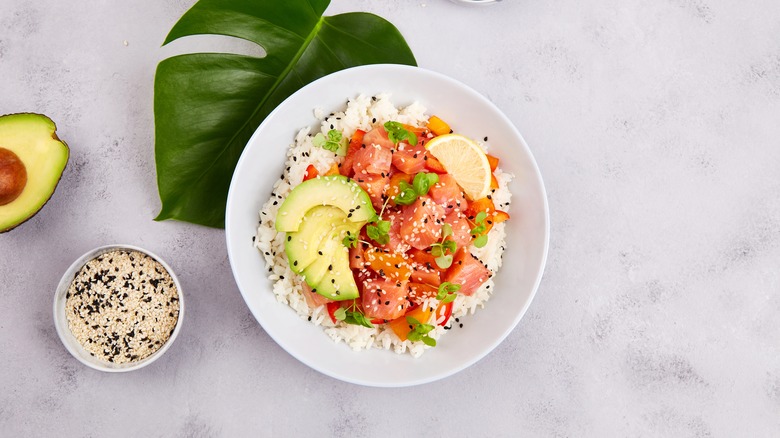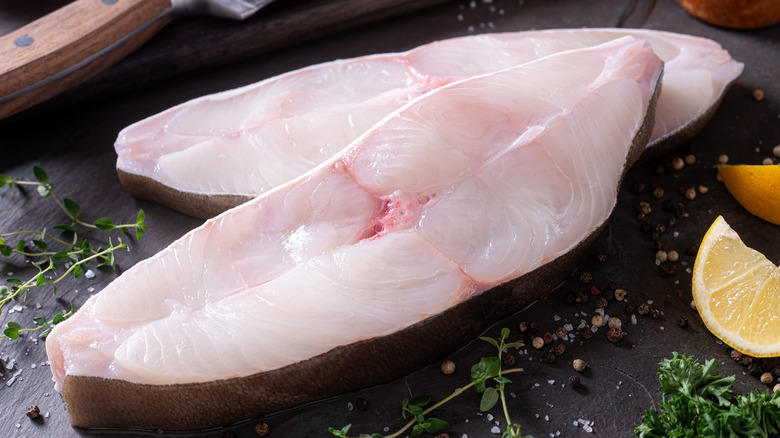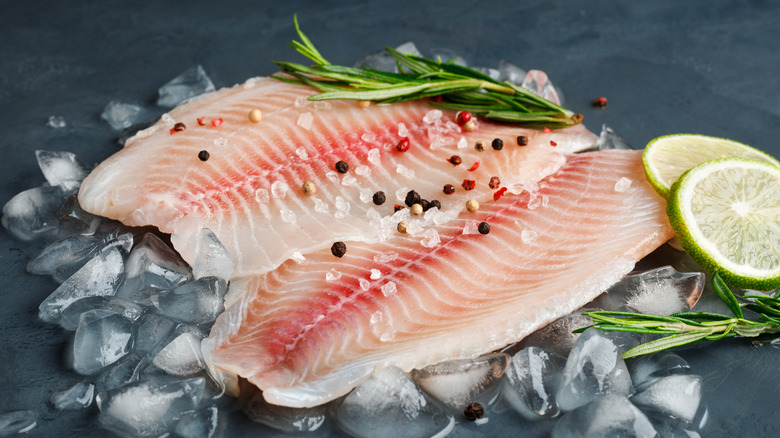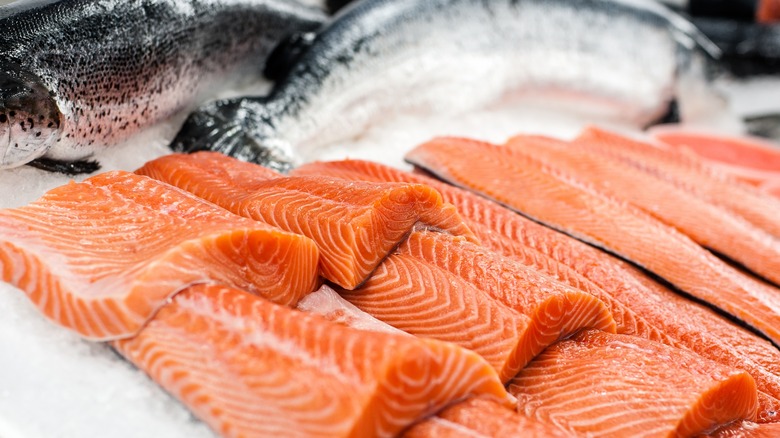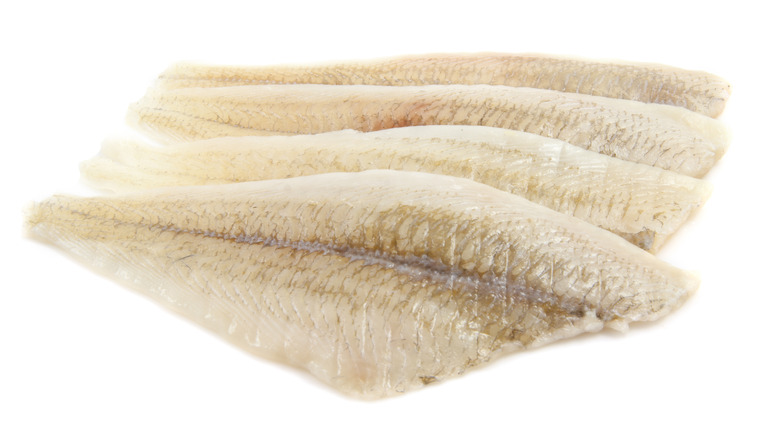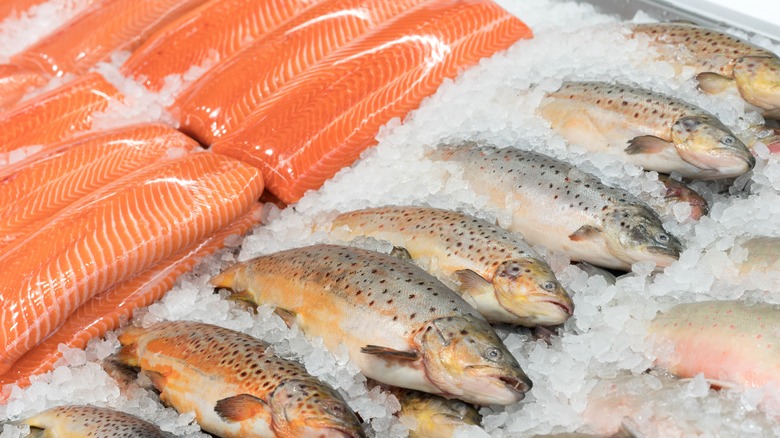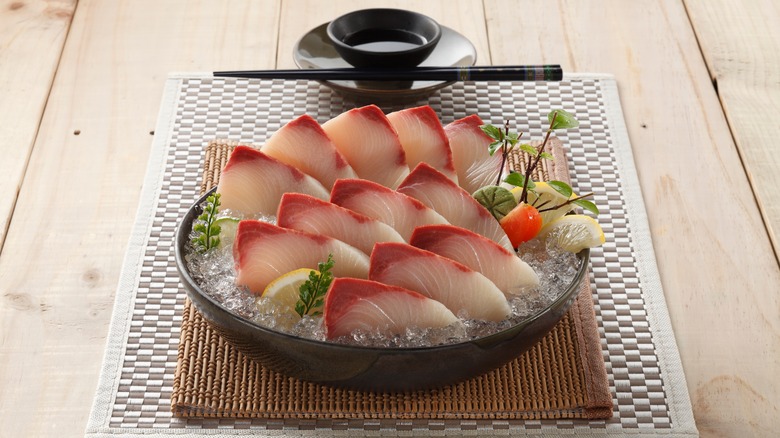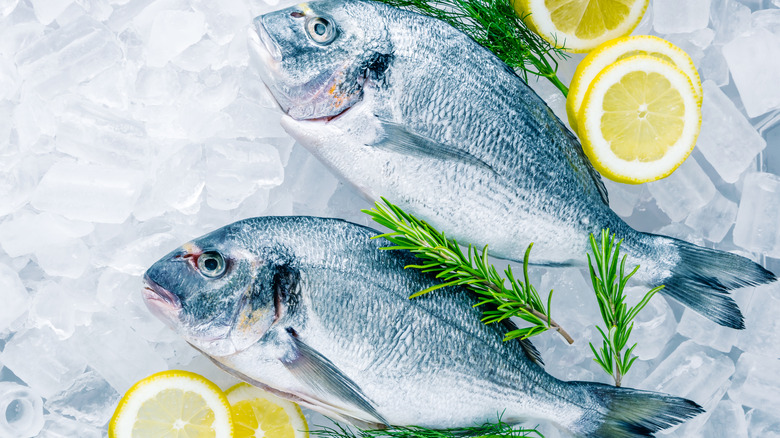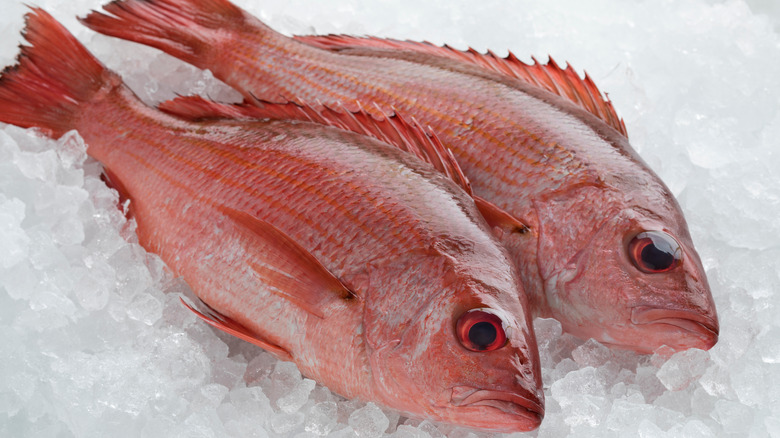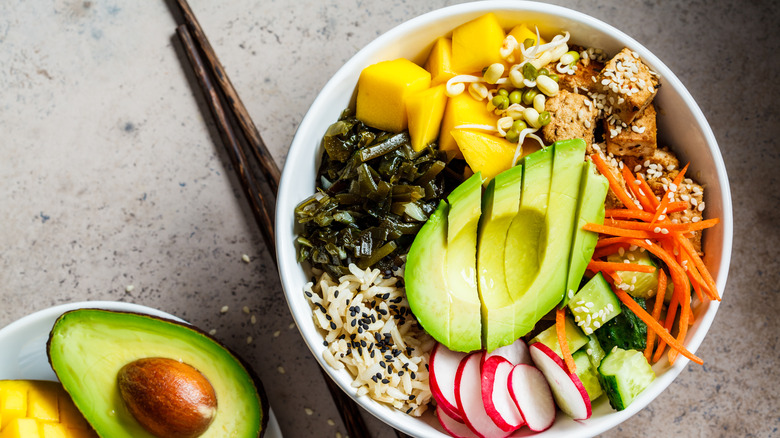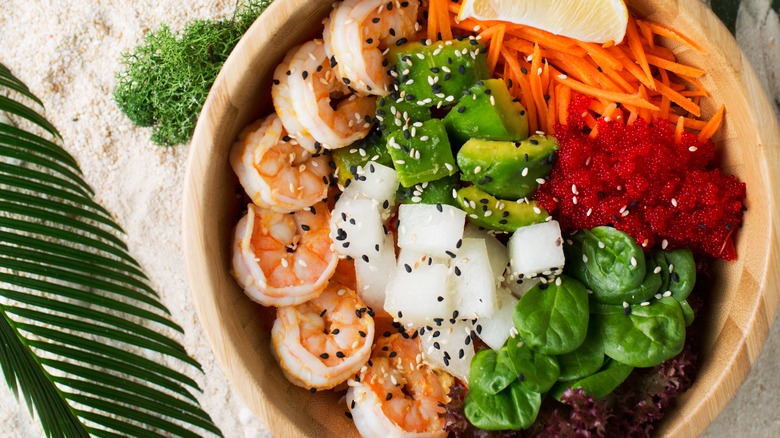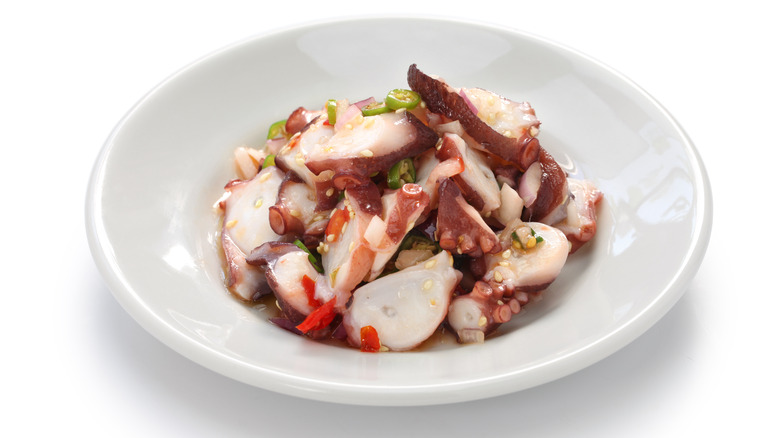11 Fresh Alternatives For Tuna In Traditional Poke
Traditional poke, according to Hawai'i Magazine, has origins going back to Indigenous Hawaiian tribes. Prior to European contact, they ate chunks of raw Pacific fish with sea salt and underwater vegetation with a crushed, roasted kukui nut condiment called inamona. Since then, the infusion of Asian cultures by generations of Korean, Japanese, and Chinese families resulted in the addition of ingredients like sesame oil and Japanese-style soy sauce. Poke's popularity exploded after a 2016 New York Times write-up on "Sons of Thunder," a restaurant that had issues getting their gas turned on and decided to make poke bowls with raw tuna originally slated for tuna steak sandwiches.
Poke's popularity soared afterward with poke bowls becoming the most popular delivery food in 2017. Perhaps due to its popularity and versatility, really incredible poke bowls can be found across the U.S. to rival some of the best poke bowls in Hawaii. "Poke" means "to cut" in English, and is a perfect descriptor for the cubed chunks of marinated fish that make up the main ingredient in a poke. Although you should use cold fish to make poke and there are some good rules of thumb around how you should be seasoning poke, there's no reason to feel hamstrung by your seafood options. Aside from tuna, there are several types of tropical fish that are absolutely delicious, and lots of fish off the U.S. coastline that are equally as good options for a poke bowl.
Halibut
Halibut is a sweet and lean white fish found in the U.S. Atlantic, Pacific, and Alaskan waters. It's a great fish for deep frying in a fish and chips platter but is apparently quite easy to overcook on the stove, which saps the moisture from the fish. However, this liability becomes a strength when considering it as an ingredient in a poke. No cooking means no risk of overcooking, which allows for some assurance your fish will stay fresh in your poke bowl.
According to Global Seafoods, your best choice of halibut for your poke is likely the Pacific halibut due to its lower overall mercury count and management by sustainable fisheries. Halibut is low in fat, high in protein, and packed and loaded with healthy nutrients like vitamins B12, B6, niacin, magnesium, and selenium.
Ask your fishmonger for a deboned, skin-free 1-pound halibut fillet. Take it home, dice your raw halibut up into cubes, and place it in a mixing bowl. Chop up three green onions, and a red or green chili, and toss them in with your halibut. Then, use a cheese grater to gently remove the skin of two limes before slicing both in half. Squeeze the lime juice over your halibut mixture along with the lime zest, and finish it off with 3 tablespoons of sesame oil and 2 tablespoons of soy sauce. Mix everything together in the bowl, and voilà! A perfect halibut poke.
Sea bass
According to Britannica, sea bass is a favorite of sport fishers and is prevalent in both western and tropical western Atlantic waters. They include well-known fisherman catches like grouper, perch, and striped bass, the latter of which we consider the best of your options for a poke. If you're wondering "what is striped bass and what it tastes like," the best way to describe it is as a fatty but not overwhelmingly fishy fish, with a hint of sweetness and a hybrid lobster/tuna texture. When shopping for your halibut, stay away from anything too fishy or ammonia scented, and always opt for the freshest bass you can get.
Sea bass is great to cook whole but isn't what you want to be working with for a poke bowl. Ask your fishmonger to fillet your bass, then go home and slice one of those fillets along the grain into tiny chunks. Dice half a red onion and a wedge of watermelon on a separate cutting board along with chopped chili and strips of nori, aka dried seaweed. Cut ½ an avocado into tiny cubes and throw it, and all the aforementioned ingredients, into a bowl with 1 teaspoon of black sesame seeds. For your acid, mix the juice of one lime and 1 teaspoon of rice wine vinegar in a salad bowl with 2 tablespoons of soy sauce. Now, toss all your chopped ingredients into the bowl and mix together until everything is coated in your Asian-influenced poke marinade.
Salmon
Luckily, salmon is readily available to us in North America, and whether wild-caught or farmed, it provides another fish source that's perfect for a poke. When it comes to the most flavorful type of salmon you can buy, sock-eyed salmon offers an amazing seafood taste that is often used as the go-to ingredient in the sushi master's repertoire. As such, this also makes this one of the best alternatives to tuna in a raw poke bowl you can get. Alternatively, if we were to think about types of salmon ranked worst to best, it's probably better to stay away from a chum or pink salmon due to coarser meat or lower oil content (both elements don't mix well in a poke bowl).
For a quick and easy poke bowl for a dinner party of four, cut a pound of filleted and deboned sushi-grade salmon into cubes. Get your salmon in a salad bowl with 2 chopped scallions, and 2 cups of chopped or shredded cabbage. In another mixing bowl, add 4 tablespoons of soy sauce, 2 tablespoons of sriracha, 2 tablespoons of honey, 2 tablespoons of rice wine vinegar, 2 teaspoons of grated ginger, and 2 crushed cloves of garlic. This is a spectacular balance of sweet, savory, and spicy that doesn't need more than a bed of white rice to make a complete and filling meal.
Fluke
It's no fluke that this fish makes our list of tuna alternatives. American Restaurant describes fluke as an Eastern Atlantic fish with an easygoing flavor profile and texture similar to our aforementioned halibut. That being the case, it's great to eat raw as long as it's well-marinated and given the consideration that it deserves in your poke bowl.
Although traditional poke calls for rice, if you want to try something new, boil up some soba noodles and let them cool for a few minutes before prepping the rest. If you're dining alone, cut up a ¼ pound of fluke with 1 cup of ogo, aka fresh seaweed, and 2 tablespoons of toasted and ground sesame seeds. For the marinade, slice and strain the juice of two lemons into a bowl with 1 teaspoon of chili oil, 1 tablespoon of soy sauce, and 1 teaspoon of grated ginger. Mix your fluke, marinade, soba noodles, and all the other ingredients together, and enjoy this different take on a poke bowl.
Ocean trout
Ocean trout, according to Tackle Village, can be enjoyed raw and often is in sashimi at your local sushi outpost. Although parasites can be present in raw trout, it's usually unlikely, and even if they are, the resulting effects aren't especially dangerous. Most trout generally have a lighter-tasting salmon flavor that can be eaten raw as long as it's been frozen for at least 24 hours prior to eating, as it helps kill potential parasites. Citrus is a great acid that works incredibly well with trout and gives it a freshness of taste, texture, and smell that brings out its natural salts and flavors.
In terms of what to do with your trout, start with the marinade. Mix 2 tablespoons of sesame oil, 1 tablespoon of rice wine vinegar, 1 tablespoon of soy sauce, a finely chopped clove of garlic, the juice of one lemon, and the juice of a whole grapefruit. Slice a 1-pound fillet of skinless ocean trout into bite-sized pieces alongside 1 diced cucumber, 2 slivered radishes, and chopped cilantro. Mix your citrus-cilantro marinade together with the other ingredients and enjoy this Asian-Latin fusion ocean trout poke.
Hamachi
It's easy to understand why tuna is often thought of as a natural poke bowl accompaniment in terms of protein. Everything you need to know about maguro, aka bluefin tuna in Japan, is that its role in your favorite nigiri makes it one of the best raw fish and rice combinations. However, a close second to that is Hamachi, often confused for tuna because of its association with the often misnamed yellowtail tuna — yellowtail isn't actually tuna, it's a type of amberjack. However, it's ironically Hamachi's similarities to tuna that make it a winning alternative to tuna. Also, that this fish contains the highest amount of protein doesn't hurt, either.
Cube a fillet of Hamachi together with 1 cucumber and 1 avocado. Toss your diced fish, cucumber, and avocado into a bowl. Chop up one scallion, 1 Thai chili, and 1 Vidalia onion with 1 teaspoon of sesame seeds and add them to the bowl. Then add the zest and juice of 2 whole lemons with 4 teaspoons of soy sauce, and 2 teaspoons of extra-virgin olive oil, and let it rest together for five minutes. Serve this over white or brown rice for a Hamachi poke beyond your wildest dreams.
Sea bream
The moist white meat and fresh flavor profile of sea bream — a nickname affiliated with the gold bar on its head — makes it an under-appreciated fish. Like most fish, it's heart-healthy and anti-cancer causing with an extremely high mineral and protein count. Aside from its versatility for cooking, it also works in sushi and sashimi, which makes it a suitable replacement for tuna in a poke, too.
To make the most of your sea bream, thinly slice 2 radishes with a mandolin, a cucumber, 4 scallions, and a teaspoon of grated or minced ginger and place together in a bowl with a ½ pound of sea bream fillet. Mix 1 tablespoon of maple syrup, 2 tablespoons of tamari, 2 tablespoons of sesame oil, 2 teaspoons of crushed red chili flakes,1 tablespoon of white wine vinegar, and the zest and juice of 2 limes in a separate bowl before combining with the sea bream mixture. All you need to make it a meal is a heaping bowl of white, brown, or even wild rice, depending on your mood.
Red snapper
Red snapper is not just delicious but also sustainably sourced and farmed. So not only are you considering your health and hunger by eating it, you're actually helping the ecosystem. Red snapper meat has a mid sweetness but pronounced flavor that is all it's own.
According to WebMD, this red deep-water fish with large snapping jaws has a number of health benefits, including the promotion of healthy thyroids, cognitive awareness, eyesight, and other things. Taste-wise, the dense yet juicy texture of its flesh, and its slightly nut-like flavor make it a favorite of many seafood lovers. There are a number of ways to cook it, but with poke on our minds, none of that is even necessary.
Red snapper poke takes the best elements of red snapper and elevates them with the tartness of pickled onions, the creaminess of coconut milk, and the sweet and sour influx of Asian-themed flavors. It's still a poke bowl but probably better than anything you would expect from the humble red snapper.
Plant-based
According to The New York Times, there are a few reasons for the rise of plant-based fish. For one thing, people are more climate aware in general, so they have a better understanding of how overfishing impacts our oceans and a willingness to do something about it. Secondly, plant-based food producers have gotten better over time at making fish alternatives better mimic the taste and texture of real fish. Right now, the market is small, with plant-based seafood making up just 0.1% of the country's seafood sales. However, there's been a huge uptick in investment from one million dollars in 2017 to upwards of 83 million dollars in 2020. In fact, plant-based fish producer Kuleana is already supplying sushi-grade plant-based alternatives to the national restaurant chain Poké Bar.
Assuming you don't have your own chain of restaurants, you can still be your own alternative seafood provider. There are several unexpected fruits you can use to create vegan tuna like tomatoes with smoked sea salt, onion, and grated ginger or watermelon soaking in an Asian-style poke marinade to name a few. If tofu agrees with you, try marinating tofu in a ¼ cup of tamari or soy sauce, with a teaspoon of sesame oil, 2 crushed cloves of garlic, the juice and zest of one lime, and a ¼ cup of grated ginger before adding it to your poke bowl favorites.
Shrimp
One common mistake everyone makes with shrimp is underestimating its versatility in things like poke. With an abundance of healthy nutrients like potassium, iron, and zinc, shrimp is a fair alternative to tuna in any poke. Cheaper than most seafood, it's perfect in the sort of layered marinade required of poke, and citric acids only make shrimp that much better in terms of taste. Like any seafood, shrimp is best when it's fresh, properly thawed before use, and deveined with its outer shell removed.
There are many types of shrimp you could consider for your shrimp poke bowl, including brown rock shrimp, brown shrimp, humpback shrimp, ocean shrimp, Pacific white shrimp, pink shrimp, royal red shrimp, spot shrimp, white shrimp, and plant-based shrimp-like Mind Blown coconut shrimp. Although there is a difference between shrimp and prawns, mainly related to size, region, and flavor, ridgeback prawns and giant freshwater prawns also make the grade.
Try spicing up your poke bowl by marinating ¾ pounds of shrimp in 2 tablespoons of soy sauce, 2 teaspoons of toasted sesame oil, 2 teaspoons of rice wine vinegar, and the juice and zest of one lemon. Add your shrimp and some of the marinade into a bowl with 2 cups of iceberg lettuce, 2 cups of diced cucumber, and the flesh of one mango diced into bite-sized pieces.
Octopus
Octopus is less commonly thought of as a poke alternative but should be considered an option. Even though sushi masters employ thinly sliced octopus in sashimi, it's still considered an outlier even in sushi circles. While its mild taste makes octopus perfect for the complex flavors of poke, its naturally rubbery texture calls for a little extra work to make eating it more pleasant. Yes, a big part of poke is the raw fish element, however, octopus requires boiling in salt water to reduce the chewiness. Packed with protein while having typically low mercury counts due to their limited life spans, it may be worth the extra effort.
Although you can purchase parboiled octopus in a variety of Asian food markets, you can also prepare your octopus in a large pot of salted water for about 10 minutes. Place your octopus into a second pot of ice water for another 10 minutes, then you should thinly slice its tentacles. Place the octopus in a bowl and add one scallion, 4 ounces of kimchi, 4 teaspoons of soy sauce, 1 tablespoon of toasted sesame oil, and 1 teaspoon of honey. Stir the ingredients together before resting on a bed of steamed rice. Add chopped chili, chili oil, or gochugaru (Korean chile flakes) and salt to taste.
While the preparation of octopus for this poke will tack on a few more minutes than many tuna alternatives, this is definitely an instance when it pays to take your time mixing poke.
